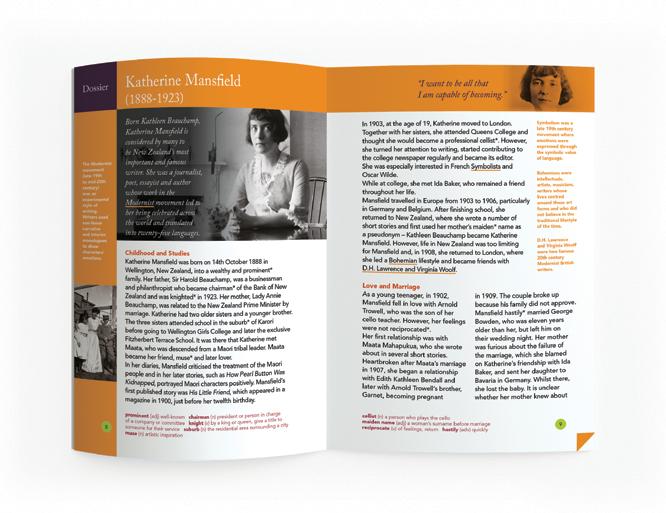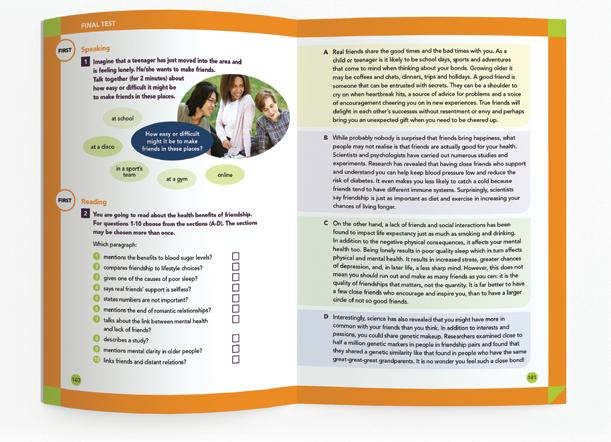Katherine Mansfield
James Joyce Oscar Wilde
Rabindranath Tagore
Mark Twain

Katherine Mansfield
James Joyce Oscar Wilde
Rabindranath Tagore
Mark Twain
The Pleasure of Reading

The Greenwich Meridian is the imaginary line that is exactly at 0° longitude: every place on Earth is measured from this line, known as the Prime Meridian. Here, east and west meet.
Just as the Greenwich Meridian is the meeting place between space and time, the eliGreenwich series is the meeting place of all those readers who immerse themselves in different times and spaces in these pages, discovering characters, stories, and real or imaginary worlds. It is a journey that crosses civilizations, seas, and known or unexplored lands, on its ideal route from the North Pole to the South Pole. A journey that is an adventure: the adventure of reading, of losing yourself in the pages of a book.
Information about the author, the story and the historical period.
Brief descriptions of the main characters.

The text with cultural details, brief summaries and glossary.






Pre-reading activities.
A wide variety of activities covering Cambridge Exam Certificates, State exams, 21st Century Skills and 2030 Agenda topics.
A final test to check what you remember.
A transcript of one of the most important scenes from the story to act out together in class.
Sir Arthur Conan Doyle The Sign of the Four
E. Gaskell, K. Chopin, K. Mansfield, V. Woolf, E.Wharton Portraits of Women
Robert Louis Stevenson The Strange Case of Dr Jekyll and Mr Hyde
Geoffrey Chaucer The Canterbury Tales
Jane Austen Pride and Prejudice
Lewis Carroll Alice in Wonderland
Oscar Wilde The Canterville Ghost
H.G. Wells, G. Orwell, E.A. Poe, S.O. Jewett, V. Woolf One Planet, One Goal
Mary Shelley Frankenstein
George Orwell Animal Farm
K. Mansfield, J. Joyce, O. Wilde, R. Tagore, M. Twain Tales of Friendship
Charlotte Brontë Jane Eyre
Oscar Wilde The Picture of Dorian Gray
H.G. Wells The Time Machine
Retold and Activities Alex Peet
Anthology Selection Silvia Rizzi
Series Editors Paola Accattoli, Grazia Ancillani
Art Director Daniele Garbuglia
Graphic Design Emilia Coari
Production Manager Francesco Capitano
Photo Credits Shutterstock
© 2023 ELi, Gruppo editoriale ELi
Printed
23.83.287.0
ENG016.01
ISBN 978-88-536-3979-0
www.gruppoeli.it

 The Devoted Friend
The Kabuliwala
The Kabuliwala
Mina
Mahony
The Miller
Narrator
Hans
The Devoted Friend
The Kabuliwala
The Kabuliwala
Mina
Mahony
The Miller
Narrator
Hans
The Modernist movement (late 19th to mid-20th century) was an experimental style of writing. Writers used non-linear narrative and interior monologues to show characters’ emotions.

Born Kathleen Beauchamp, Katherine Mansfield is considered by many to be New Zealand’s most important and famous writer. She was a journalist, poet, essayist and author whose work in the Modernist movement led to her being celebrated across the world and translated into twenty-five languages.

Katherine Mansfield was born on 14th October 1888 in Wellington, New Zealand, into a wealthy and prominent* family. Her father, Sir Harold Beauchamp, was a businessman and philanthropist who became chairman* of the Bank of New Zealand and was knighted* in 1923. Her mother, Lady Annie Beauchamp, was related to the New Zealand Prime Minister by marriage. Katherine had two older sisters and a younger brother. The three sisters attended school in the suburb* of Karori before going to Wellington Girls College and later the exclusive Fitzherbert Terrace School. It was there that Katherine met Maata, who was descended from a Maori tribal leader. Maata became her friend, muse* and later lover. In her diaries, Mansfield criticised the treatment of the Maori people and in her later stories, such as How Pearl Button Was Kidnapped, portrayed Maori characters positively. Mansfield’s first published story was His Little Friend, which appeared in a magazine in 1900, just before her twelfth birthday.
prominent (adj) well-known chairman (n) president or person in charge of a company or committee knight (v) by a king or queen, give a title to someone for their service suburb (n) the residential area surrounding a city muse (n) artistic inspiration
In 1903, at the age of 19, Katherine moved to London. Together with her sisters, she attended Queens College and thought she would become a professional cellist*. However, she turned her attention to writing, started contributing to the college newspaper regularly and became its editor. She was especially interested in French Symbolists and Oscar Wilde. While at college, she met Ida Baker, who remained a friend throughout her life. Mansfield travelled in Europe from 1903 to 1906, particularly in Germany and Belgium. After finishing school, she returned to New Zealand, where she wrote a number of short stories and first used her mother’s maiden* name as a pseudonym – Kathleen Beauchamp became Katherine Mansfield. However, life in New Zealand was too limiting for Mansfield and, in 1908, she returned to London, where she led a Bohemian lifestyle and became friends with D.H. Lawrence and Virginia Woolf.

As a young teenager, in 1902, Mansfield fell in love with Arnold Trowell, who was the son of her cello teacher. However, her feelings were not reciprocated*. Her first relationship was with Maata Mahapukua, who she wrote about in several short stories.
Heartbroken after Maata’s marriage in 1907, she began a relationship with Edith Kathleen Bendall and later with Arnold Trowell’s brother, Garnet, becoming pregnant
Symbolism was a late 19th century movement where emotions were expressed through the symbolic value of language.
Bohemians were intellectuals, artists, musicians, writers whose lives centred around these art forms and who did not believe in the traditional lifestyle of the time.
D.H. Lawrence and Virginia Woolf were two famous 20th century Modernist British writers.
in 1909. The couple broke up because his family did not approve. Mansfield hastily* married George Bowden, who was eleven years older than her, but left him on their wedding night. Her mother was furious about the failure of the marriage, which she blamed on Katherine’s friendship with Ida Baker, and sent her daughter to Bavaria in Germany. Whilst there, she lost the baby. It is unclear whether her mother knew about
cellist (n) a person who plays the cello maiden name (adj) a woman’s surname before marriage reciprocate (v) of feelings, return hastily (adv) quickly
“I want to be all that I am capable of becoming.”
the pregnancy, but she cut Katherine out of her will*. In 1910, she returned to London and had numerous articles published in The New Age magazine. In 1911, Mansfield began a relationship with John

Middleton Murry, the editor of the literary magazine Rhythm who had rejected one of her stories because it was too light. She responded by submitting a story of a murder and mental illness. Their relationship was on-off over the years and continued to be so even after their marriage in 1918; they separated on a number of occasions and lived apart for extended periods.
Mansfield had suffered from ill health for several years and, in December 1917, she was diagnosed with tuberculosis. She was twenty-nine years old. After staying with a friend in Cornwall for a few months, she decided to move to France to avoid the colder English winters. However, she was not happy there and her health got worse. In March 1918, she had a haemorrhage*. Over the winter of 1918-1919, Mansfield stayed in a villa in San Remo with her friend Ida Baker. Things between them became difficult, and Mansfield suffered from depression. She wrote to her husband about her feelings, and despite their own difficult relationship, Murry went to spend Christmas with them. This inspired Mansfield to write a short story called The Man Without a Temperament, about a patient man and his ill wife. In May 1921, Mansfield went to Switzerland for treatment for her tuberculosis, and Ida Baker accompanied her. Murry joined Mansfield shortly afterwards, and they stayed there until January the following year.
will (n) document stating who you want to receive your money and property after your death haemorrhage (n) bleeding internally
“Make it a rule of life never to regret and never to look back.”
Mansfield tried alternative cures for tuberculosis, travelling to Paris and back to Switzerland. After a brief period in London in the summer of 1922, Mansfield went to Fontainebleau with Ida Baker. On 9th January 1923, she suffered a haemorrhage after running up the stairs and died an hour later aged thirty-four.
Mansfield wrote a great number of articles, poems and short stories during her life. Her first collection was not published until 1911. It was entitled In a German Pension as a reference to the time she had spent in Bavaria. The death of her younger brother, Leslie Beauchamp, in October 1915 at Ypres in Belgium, had a profound effect on her and her writing. She began to think nostalgically about their childhood in New Zealand. She wrote a series of short stories based
on family memories of New Zealand, which were published in 1918 as Prelude. Her second collection Bliss appeared in 1920 and made her reputation. She was particularly productive during her time in Switzerland, feeling that she did not have long to live. She wrote numerous short stories, including The Garden Party, At the Bay, The Doll’s House, and A Cup of Tea. After her death, her husband collected her unpublished works and released them as two further volumes of short stories: The Dove’s Nest in 1923, and Something Childish in 1924; a volume of poems and collections of her letters and journals.
Complete the table about Katherine Mansfield.

Date of birth:
Nationality: First story published: Collection that made her famous:
Married to: Died:
“The pleasure of all reading is doubled when one lives with another who shares the same books.”
1 Read the text and then answer the questions below.
Katherine Mansfield’s short story The Doll’s House first appeared in 1922 in a weekly newspaper called Nation and Athenaeum, which published both political articles and literary content. After Mansfield’s death, her husband included the short story in the 1923 collection The Dove’s Nest and Other Stories. The Doll’s House is set in rural New Zealand and describes the rigid social classes of the time. The Burnells are a wealthy family who send their daughters to the local school because there is no other choice. Although they are obliged to attend the school, the girls are not allowed to mix with all the children there and particularly not the low-class Kelvey sisters, who they cannot even speak to. The arrival of a doll’s house leads Kezia, the youngest Burnell girl, to break the rules.
1 When was The Doll’s House published for the first time?
2 What type of content did Nation and Athenaeum publish?
3 Who included The Doll’s House in a 1923 collection of short stories?
4 What is society like in New Zealand in The Dolls House?
5 Are the Burnells happy to send their daughters to the local school?
6 What rules do they impose on their daughters?
7 Why are the Burnell sisters not allowed to talk to the Kelveys?
8 How does the doll’s house affect Kezia’s behaviour?
2 Match the words in the box to the pictures below. Use a dictionary for any you don’t know.
pane dresser jug plate hook penknife porch crib


3a Use your dictionary and match the verbs to their definitions.
1 sneer
2 shun


3 hiss
4 giggle
5 blush
a laugh in a silly or childish way
b of face, to turn red, normally due to embarrassment

c whisper angrily
d avoid or reject because of dislike

e smile in a nasty way
3b Now choose the most appropriate verb and form for each of these sentences.
1 The Burnell sisters never mixed with the Kelveys. They them.
2 She found the situation very funny and


3 Whenever a teacher calls my name in class I
4 ‘You’ll pay for this!’ she
5 The wealthy girls often at the poorest girls when they walked past.